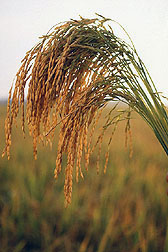This page has been archived and is being provided for reference purposes only. The page is no longer being updated, and therefore, links on the page may be invalid.
|
|
Rice Collection Identifies Valuable Traits
By Jim CoreDecember 13, 2004
Agricultural Research Service scientists recently completed an agronomic analysis of an important rice genebank, providing breeders with valuable information that they can use to improve this vital crop.
The researchers analyzed the U.S. Department of Agriculture Rice Core Collection, part of the National Small Grains Collection (NSGC). The rice core collection's 1,801 entries represent about 10 percent of the 17,396 rice accessions in the NSGC.
The ARS analysis shows that the core collection captures more than 70 percent of the genetic variation in all the NSGC lines, according to estimates. Reaching this milestone will help researchers to find genes that have important traits and to transfer those genes to commercial cultivars.
NSGC is part of the ARS-coordinated National Plant Germplasm System (NPGS), a cooperative effort by public and private organizations to preserve the genetic diversity of plants. Accessions are included in a database so scientists worldwide can search for specific characteristics that interest them, and can request the germplasm for research.
Wengui Yan, a geneticist at the ARS Dale Bumpers National Rice Research Center (DBNRRC) in Stuttgart, Ark., leads efforts to build the core collection. He completed the agronomic analysis in collaboration with Tom Tai, a rice geneticist in the ARS Crops Pathology and Genetics Research Unit at Davis, Calif.; Harold Bockelman, curator of NSGC in Aberdeen, Idaho; and J. Neil Rutger, director, DBNRRC.
Last year, Yan froze leaf tissues of the core collection lines for molecular analyses. Molecular geneticists have developed 183 Simple Sequence Repeat (SSR) markers to locate genes that determine agronomic traits and quality. The ARS scientists at Stuttgart have completed the SSR analysis for 300 of 1,801 entries.
ARS scientists at the Rice Research Unit in Beaumont, Texas, assisted by analyzing molecular markers related to grain quality. Thanks to joint federal and state efforts, 21 out of 30 descriptors used to describe plant traits, such as aroma and pest resistance, have been evaluated for this collection.
ARS is the USDA's chief scientific research agency.

